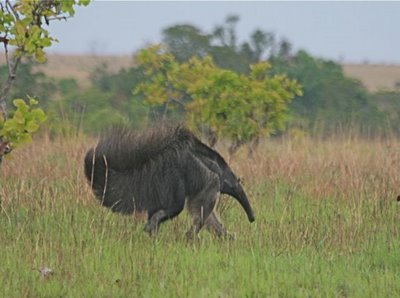
Though an adult's body is 3 1/2' long, its tongue can extend two more feet. It is detached from the hyoid bone and extends deep into the thorax to the breastbone! Coated with sticky saliva, the tongue lances into termite and ant mounds and instantly ensnares workers and larvae. It lashes forward and back, up to 150 times per minute, dragging the ants and termites to their demise. The anteater strikes and flees before the powerful soldier ants can mount an organized defense. As many as 30,000 insects may fall prey each day. No wonder a giant anteater's home range may cover more than 22,200 acres! Odder yet than its mobile tongue is its skull. The anteater has no jaws; its maxilla and mandible are fused into a single bony tube; thus it cannot open its mouth more than an inch or so. Imagine.
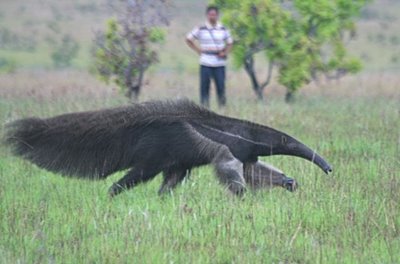
Ecotourism is in its infancy in Guyana, and having run with lightning speed over rough terrain and sent the anteater practically into our arms, our guides glowed with pride that they were able to give us such a thrilling experience. I couldn't fault them; they gave us what they thought we would want. They were great guys.
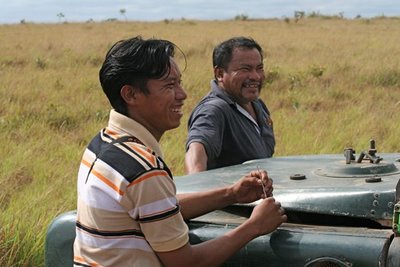 The nuances of watching wildlife without disturbing it have yet to enter into the equation in the isolated case of Karanambu's giant anteaters. (Everywhere else we went, wildlife was approached cautiously and with a great deal of respect. I suspect this driving approach is viewed as the only surefire way to give tourists a decent view of a reclusive mammal). How much more preferable it would have been for us to view the anteater at a distance, perhaps from an elevated platform with a spotting scope, than to stress it this way! Having no scope, the guides resorted to herding it. I can't think about my first, and perhaps only, sighting of this rare animal without a pang of guilt and shame. There has to be a better way. Individually and as a group, we expressed our distress to the trip organizers, pleading the anteater's side of things.
The nuances of watching wildlife without disturbing it have yet to enter into the equation in the isolated case of Karanambu's giant anteaters. (Everywhere else we went, wildlife was approached cautiously and with a great deal of respect. I suspect this driving approach is viewed as the only surefire way to give tourists a decent view of a reclusive mammal). How much more preferable it would have been for us to view the anteater at a distance, perhaps from an elevated platform with a spotting scope, than to stress it this way! Having no scope, the guides resorted to herding it. I can't think about my first, and perhaps only, sighting of this rare animal without a pang of guilt and shame. There has to be a better way. Individually and as a group, we expressed our distress to the trip organizers, pleading the anteater's side of things.Baby giant anteaters crawl up their mother's legs immediately after birth, to ride clinging to her chest, or astride her like a tiny jockey. Having no jaws with which to pick the baby up, the mother depends on the baby to position itself, and waits for it to cling to her before moving away. This photo from the National Zoo depicts a baby born there on July 24, 2007. Oh my goodness.
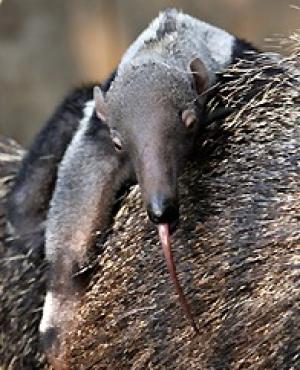 OK, do they nurse? My sources say they do, but how, if their tongues are long and snaky and they have no jaws? Arrggh. Need to know. Having just viewed some of the amazing giant anteater videos at Arkive.org, and seen the anteater's oral apparatus up close, I'm less concerned. I can imagine even this snaky-tongued youngster mustering up a pretty good vacuum with its tiny mouth. (Thanks, rmharvey!) Various sources have the young nursing from two to six months, riding on mama for up to nine months. Giant anteaters are thought to live up to 15 years in the wild, and have lived to 26 years in captivity.
OK, do they nurse? My sources say they do, but how, if their tongues are long and snaky and they have no jaws? Arrggh. Need to know. Having just viewed some of the amazing giant anteater videos at Arkive.org, and seen the anteater's oral apparatus up close, I'm less concerned. I can imagine even this snaky-tongued youngster mustering up a pretty good vacuum with its tiny mouth. (Thanks, rmharvey!) Various sources have the young nursing from two to six months, riding on mama for up to nine months. Giant anteaters are thought to live up to 15 years in the wild, and have lived to 26 years in captivity.Seaworld and Busch Gardens have a wonderful website , from which I garnered the following bit of animal trivia:
When I read that, my heart sank. What do we know about the giant anteater's metabolism? What do we know about what happens when you chase a cool-blooded giant anteater around in stifling heat? Nothing. We know that that's a good way to get a close look at it. But...we also know that they're disappearing throughout their range; I've seen one estimate that places the global population at 5,000. We had seen one of that sadly dwindling number, and we had done him no good. Here comes the pang again.
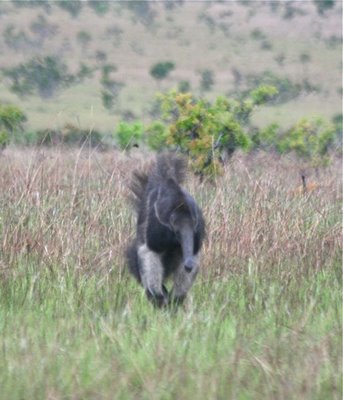
Like many wondrous animals, giant anteaters are disappearing, and are listed as Threatened/Vulnerable under CITES. At the very least, we owe it to them to admire them from a distance, to observe them living their lives undisturbed, to respect their dignity and their place on the planet, and leave them unharmed by our interest. May their glorious oddity, and our curiosity about them, not prove to be their demise.






19 comments:
You're so right. I'm sure the feedback will help. To change the subject for a moment, check today's Cuteoverload - 3 (!) Bostons.
That second picture is just glorious; what a creature, and one wonders what thoughts were passing through it's mind at that moment.
Human curiosity... definitely a two-edged sword...
I certainly envy you the encounter... But I also share your concern and wish for a better way to see these creatures. I'm all for the no-disturbing approach to wildlife. The less impact I have, the better I feel about it.
And kudos to you and your group for speaking up later, for voicing your concerns without making it a problem for the guides. You said it best: They probably don't know better, at least not yet.
You should feel no guilt. You did not know that was the way it would be presented particularly because all other encounters had been handled properly. And you did not quietly accept it, but took a stand for the anteater. Well done. Education is always your first priority whether it is us as your readers or the ones you encounter out there in the real world.
A very powerful and informative series of posts, Julie. The writing here was fantastic, and I totally felt like I was right alongside you, feeling joy and guilt simultaneously.
I am glad to hear that you all voiced your concerns to the trip organizers, and I'm sure they will take your words into consideration for future groups, especially since they already treat other species with respect.
Thank you, as always, for sharing your great experiences with us.
Word verification: honing
Hugs to you, Julie, for feeling concern. I would have, too, esp. now knowing more about their hearts and metabolism... Chasing them for human pleasure - perhaps once does no harm but I would not intend to scare the life from an animal...
I'm amazed to see one!
"...its tongue can extend two more feet.." Incredible.
Thank you!
Mare
I too am glad you spoke up. What a remarkable animal, kind of odd looking, but graceful too. The amazing diversity of life on this planet leaves me wide-eyed.
Yes, good to speak up and gently guide them to a better technique.
Remarkable trip you had.
Wow-I now know from where George Lucas got ideas for some of his fantastic creature!
Great photos!
Like you said, they are doing what they think tourists want them to do. Maybe no one has suggested a better way? Still, being able to see him and share him here is magical and brings awareness to their plight. Such a very awesome animal.
Julie, can you e-mail me? Julie Roads and I are working on a charity project and would love your help. Thanks...
Maybe the concern you and others on the trip expressed will lead to a new way of scaring up the critters without scaring the bejeezus out them.
(The anteater's rounded profile in the post's first picture brought an entirely different creature to mind: flea.)
Aggh! He does look like a giant flea!
Catbird, your comments always bring me a chuckle. I loved the one where you told the Boston terrier owner about Chet Baker. Hee hee. Curlgurl, I dug those puppehs on Cute Overload.
As you all will see in future posts, there is a huge respect for animals at Karanambu Ranch--they bend over backwards for them. The anteater situation appears to be an anomaly. I'll continue to root around for an answer to the problem.
I was disturbed by your previous post on this and I’m not feeling much better having seen the photo of that anteater trying to run away from the guides!
The eco-tourism thing is a hard nut to crack. It should be a good way for a community to earn a living, preserve habitat, and even protect a fragile cultural legacy. But for an eco-tourism outfit or a tour operator to accept practices such as you’ve described here seems to me to contradict some of the basic principles of responsible eco-tourism, which include minimizing impact on and directly contributing to conservation of the area being visited.
I think that we, as relatively well-off Northerners [because that’s largely who ecotourists are], have a responsibility to think about our choices. I think that your and your group’s solution of approaching the organizers was the best possible thing that you could do in that circumstance. I hope your intervention was truly heard.
I wish everyone who was faced with a situation like this would recognize it for what it is, and take the same kind of constructive action. Thanks for telling the story.
Little Orange Guy,
The more I think about this situation, the more I think that the problem may reside not so much with the management but with the individual guides. I think they've discovered a faster, "better" way to show people an anteater, and a Dudley Do-Right element creeps in where the guides, quite understandably, always want to "get their man." They may well be doing an end run around orders. They know that some tourists find it upsetting, but they also know that, given a choice of having an anteater chased toward them or not seeing the animal at all, most tourists would choose chase mode, not stopping to question how stressful it may be for the animal. The guides told us that this was a one-time thing, that they don't make a habit of rounding up the animal, but that they were doing it just for us, just this one time. And someone who visited the place last year was told the same thing when he reacted negatively to having the anteater chased toward him.
I have to wonder if getting a scope at Karanambu for the guides' use might alleviate the pressure on its precious anteaters. That, and continuing negative feedback from those of us who are appalled by the intrusion. It is up to us, as ecotourists, to speak up when we perceive abuse.
Good thought about the scope. How can you do things differently if you can't see?
What a very, very cool animal. That profile shot is really amazing and unusual!
Unless a particular anteater or population is regularly run for tourists, I wouldn't think that there would be too much of a negative effect on them and maybe not even then. After all, they've had to run from predators for tens of thousands of years and anything that expired as a result of the occasional escape run probably wouldn't have made it to the present day. I'm not endorsing the practice, just opining that you shouldn't feel much guilt.
I think it was very cool you got to see this giant anteater Julie, but I can certainly understand why you felt bad about the methods used to enable you to get the close-up look and I feel really bad for the anteater being pursued. I hope your words were taken seriously by the guides. Will there be any way to find out if changes are being made?
what is the giant anteaters golobal population???
Post a Comment